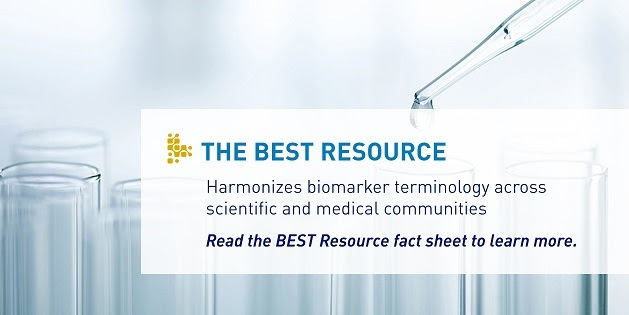

In order to promote consistent use of biomarker terms and concepts, the FDA and NIH have developed theBiomarkers, EndpointS, and other Tools (BEST) Resource, which clarifies terminology and uses of biomarkers and endpoints as they pertain to the progression from basic biomedical research to medical product development to clinical care. Learn more about the BEST Resource, how it will advance biomarker development, and how you can contribute by reading CDER’s new fact sheet. http://go.usa.gov/xWwJY
BEST (Biomarkers, EndpointS, and other Tools) Resource
FDA-NIH Biomarker Working Group.
Silver Spring (MD): Food and Drug Administration (US); Bethesda (MD): National Institutes of Health (US); 2016-.
Effective, unambiguous communication is essential for efficient translation of promising scientific discoveries into approved medical products. Unclear definitions and inconsistent use of key terms can hinder the evaluation and interpretation of scientific evidence and may pose significant obstacles to medical product development programs. Lack of clarity and consistency is also problematic in other scientific areas where FDA oversees product safety (e.g., foods and tobacco) to promote public health interests.
In the spring of 2015 the FDA-NIH Joint Leadership Council identified the harmonization of terms used in translational science and medical product development as a priority need, with a focus on terms related to study endpoints and biomarkers. Working together with the goals of improving communication, aligning expectations, and improving scientific understanding, the two agencies developed the BEST (Biomarkers, EndpointS, and other Tools) Resource. The first phase of BEST comprises a glossary that clarifies important definitions and describes some of the hierarchical relationships, connections, and dependencies among the terms it contains.
The BEST glossary aims to capture distinctions between biomarkers and clinical assessments and to describe their distinct roles in biomedical research, clinical practice, and medical product development. Because the glossary is intended to be broadly applicable to multiple communities of users and stakeholders, its definitions address nuances of usage and interpretation for a wide variety of terms currently in use. Further, based on differing stakeholder needs, it has built in flexibility, when possible and appropriate, to accommodate those interests. NIH and FDA intend to use the definitions included in this glossary when communicating on topics related to its contents (e.g., biomarkers) to ensure a consistent use of the terms and therefore, a common understanding of the issues.
The BEST glossary is meant to be a “living” resource that will be periodically updated with additional terms and clarifying information. We welcome feedback, including specific proposed edits with rationale, from all stakeholders, including the scientific and medical communities, patients, providers, industry, and regulators, so that as we refine and elaborate on these terms, they will remain relevant, thus fostering consistent usage and ultimately help to accelerate development and refinement of medical products which lead to improvements in health outcomes. Suggested revisions will be considered on a regular basis.
Contents
- FDA-NIH Biomarker Working GroupPublished January 28, 2016.
- GlossaryPublished January 28, 2016; Last Update: April 28, 2016.
The U.S. Food and Drug Administration (FDA) and the National Institutes of Health (NIH) are joint sponsors of the BEST (Biomarkers, EndpointS, and other Tools) Resource.
Bookshelf ID: NBK326791PMID: 27010052





















.png)












No hay comentarios:
Publicar un comentario